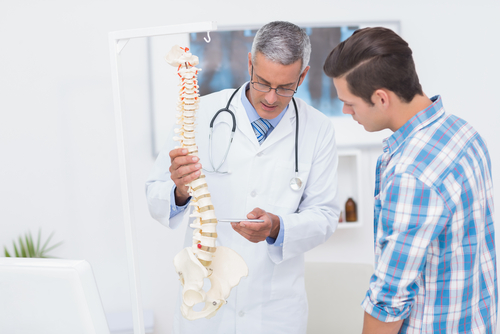
What is scoliosis?
Scoliosis is a deformity of the spine that resembles an “S” or “C” shape when viewed from the front or back.
To be diagnosed with scoliosis, the angle of a person’s spine curvature must be greater than 10 degrees. Any curve assessed under 10 degrees is considered a normal variant. Larger scoliotic curves can result in imbalance, which can cause pain and even lung or heart problems. Children and adolescents with curves ranging from 10 to 30 degrees are observed for progression. Between 30 and 50 degrees, patients are often braced, and patients whose curves measure more than 50 degrees generally require surgery.
What causes scoliosis?
Extensive research has not yet revealed the exact cause or causes of scoliosis. However, when scoliosis develops in children or adolescents, there seems to be a strong genetic predisposition, and in adolescents, it is more common in girls than boys.
Because genetics seems to play such a prominent role, with currently over 50 identified predisposing genetic markers, physicians are able to predict if the condition will worsen with age or remain relatively mild.
Can adults develop scoliosis?
While scoliosis most often occurs during childhood or adolescence it may develop during adulthood. Older adults generally develop degenerative scoliosis in the context of moderate to severe age-related changes such as degenerative disc disease or arthritis of the spine. In patients with degenerative scoliosis, pain from arthritic, degenerative joints and discs can be worsened by imbalanced loads on the spine caused by the deformity.
What are scoliosis symptoms?
Scoliosis symptoms can range from none to imbalanced posture or disabling pain. Over the past decade, spine surgeons have increasingly recognized that the degree of postural imbalance caused by scoliosis has a greater influence on symptoms and ability to function than the magnitude of the curve.
Among adults, scoliotic deformities are often accompanied by pain from an imbalanced weight on the joints of the spine and pinching of spinal nerves either from bulging discs or bone spurs, especially on the inner side of the curve.
In addition to severe back pain, adults with scoliosis may experience sciatica, a symptom of a pinched spinal nerve consisting of pain that radiates from the back to the buttocks and down the leg.
How do you treat scoliosis?
Most cases of scoliosis are mild, and treatment generally begins with a course of physical therapy with an emphasis on improving posture and strengthening abdominal muscles. Anti-inflammatory medications are sometimes prescribed.
In adolescents, prolonged bracing can slow curve worsening. However, teens with curves greater than 50 degrees may require surgery to prevent the deformity from progressing.
In adults, treatments for scoliosis vary widely depending on the extent of imbalance and neurologic dysfunction. Many mild to moderate cases can be treated without surgery using a combination of rehabilitative and strengthening exercises, anti-inflammatory medications, and occasional spinal injections. If a pinched nerve is causing unmanageable pain or weakness, surgery may be required. This surgery generally involves a decompression of the affected nerves and a fusion to stabilize the spine.
Medical imaging plays an important role in all types of surgical planning, including spinal fusion to correct scoliosis. The application of computer 3D modeling to help plan for surgical restoration of posture and the correction of scoliotic curves is an area of ongoing research.
Are you experiencing scoliosis symptoms?
An evaluation by an orthopedic surgeon is advisable for anyone experiencing scoliosis symptoms such as uneven shoulders or hips, a bump in the lower back, numbness, weakness or pain in the legs, trouble standing up straight or walking, or loss of height. After evaluating your spine and its alignment, an orthopedic expert can help you manage scoliosis pain and plan for the best treatment options.
To book an appointment with our various orthopedic specialists or for more information, visit Summit Health Orthopedics.
